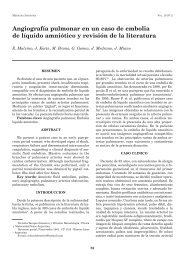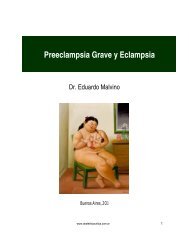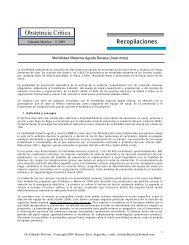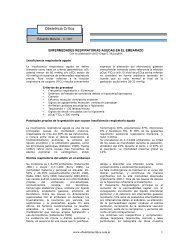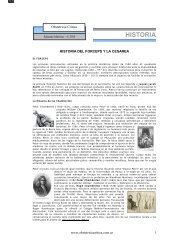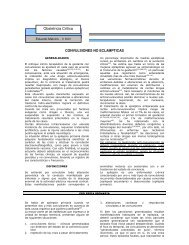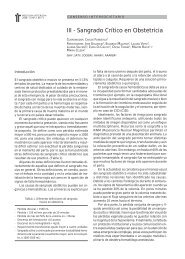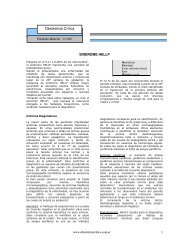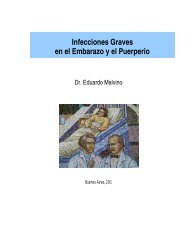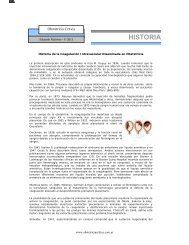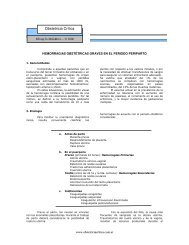Department of Obstetrics and Gynecology, Baylor College of Medicine, Houston,Texas, USA. ctung@mdanderson.orgBACKGROUND: Acute colonic pseudoobstruction, or Ogilvie's syndrome, is arare but serious medical and obstetric complication. When diagnosed early,treatment with expectant management or more invasive decompression is oftensuccessful. However, if not recognized promptly or managed appropriately, thiscondition can be fatal. CASE: We present an unusual case of acute colonicpseudoobstruction occurring after management of preterm labor in amonochorionic-diamniotic twin pregnancy at 29 weeks' gestation complicatedwith twin-twin transfusion syndrome. CONCLUSION: Acute colonicpseudoobstruction should be considered in the differential diagnosis in pregnantwomen who present with abdominal distention and vomiting.Aust N Z J Obstet Gynaecol. <strong>2008</strong> Feb;48(1):44-49.Venous thromboembolism during pregnancy and the post-partum period:Incidence and risk factors in a large Victorian health service.Sharma S, Monga D.Ballarat Health Services, Ballarat, Victoria, Australia.Background: There is a strong recommendation for post-partumthromboprophylaxis following emergency caesarean sections, particularly inoverweight women, and following prolonged labour. Aims: To analyse theincidence and epidemiological factors associated with antepartum and postpartumvenous thromboembolism in a large Victorian health service. Methods: Aretrospective study of all 6987 women delivering at Ballarat Health Servicesbetween March 1999 and June 2006. Case notes of women with confirmedvenous thromboembolism during this period were subjected to detailed analysis.The data were analysed for possible risk factors, the timing of thromboembolismin relation to the pregnancy and any correlation with thromboprophylaxis, ifadministered. Results: The rate of venous thromboembolism was 1.14 per 1000deliveries, with risk factors of age > 30 (100%), obesity (75%), previous history ofthromboembolism (62.5%) and caesarean section (37.5%). Majority of caseswere diagnosed in first trimester (62.5%), and in the right lower limb (75%). Noneof the patients had been given thromboprophylaxis. Conclusion: While theincidence and risk factors were similar to those generally quoted, a much higherincidence was found in early pregnancy, and in the right lower limb. Theimportance of meticulous screening for risk factors in early pregnancy cannot beoveremphasised.Aust N Z J Obstet Gynaecol. <strong>2008</strong> Feb;48(1):34-39.Symptomatic urinary stone disease in pregnancy.Cheriachan D, Arianayagam M, Rashid P.Department of Urology, Port Macquarie Base Hospital, New South Wales, andUNSW Rural Clinical School, Port Macquarie Campus, New South Wales,Australia.Background: Symptomatic urinary calculi are rare in pregnancy with an incidence
of one per 1500 pregnant women. Calculi may cause ureteric obstruction thatcan be further complicated by sepsis. This may have a significant morbidity formother and fetus. Objective: To provide an update on the current investigationsand management options for pregnant patients with symptomatic urinary calculi.Discussion: We discuss the different imaging modalities available to investigatethe renal tract in pregnant women and propose a management pathway. Thistopic is particularly pertinent to obstetricians in their roles as coordinators ofprenatal care.Aust N Z J Obstet Gynaecol. <strong>2008</strong> Feb;48(1):12-16.Guidelines for the use of recombinant activated factor VII in massiveobstetric haemorrhage.Welsh A, McLintock C, Gatt S, Somerset D, Popham P, Ogle R.Department of Maternal-Fetal Medicine, Royal Hospital for Women, Randwick,New South Wales, Australia.Recombinant activated factor VII (rFVIIa) is emerging as a novel therapy for thetreatment of life or fertility-threatening post-partum haemorrhage (PPH)unresponsive to standard therapy that in some cases may prevent the need forperipartum hysterectomy. The level of evidence to date for use of rFVIIa in PPHis limited to case reports and case series with one nonrandomised study. Nohigh-quality randomised controlled trials have been published at this stage,precluding a quality systematic review. Guidelines have been published for theuse of rFVIIa in non-obstetric haemorrhage, though to date none are available forPPH. A multidisciplinary group of Australian and New Zealand clinicians from thefields of obstetrics, anaesthesia and haematology, who have both clinicalexperience in and/or knowledge of rFVIIa was convened by the manufacturer.This group produced an opinion and guideline based on their experience and thepublished international literature on the use of rFVIIa. This is intended to be usedas a guideline and algorithm for the use of rFVIIa, though any use should betailored to local practice and resources.Aust N Z J Obstet Gynaecol. <strong>2008</strong> Feb;48(1):2-4.Enough is enough! Time for a new model of care for women with earlypregnancy complications.Condous G.Acute Gynaecology and Early Pregnancy Unit, Nepean Centre for PerinatalCare, Nepean Clinical School, University of Sydney, Nepean Hospital, Penrith,Sydney, and Omni Gynaecological Care, Women's Ultrasound and EarlyPregnancy Centre, St Leonard's, Sydney, New South Wales, Australia.Australian women with early pregnancy complications, like their Englishcounterparts, should have access to ultrasound-based early pregnancy units(EPUs) nationwide. This modern approach to women with first trimester problemswould not only streamline individual care pathways but also reduce the impactthat early pregnancy problems have on already overburdened public emergencydepartments. Dedicated EPUs, with trained gynaecological sonologists
- Page 1 and 2: Obstetricia CríticaEduardo Malvino
- Page 3 and 4: gestational age at delivery, Apgar
- Page 5 and 6: Maternal risk factors associated wi
- Page 7 and 8: exclusive categories: 1) bleeding r
- Page 9 and 10: Division of Obstetrics and Gynecolo
- Page 11 and 12: as uncommon as primary synovial sar
- Page 13 and 14: Cardiac Troponin I Elevation After
- Page 15: significant increase in carbohydrat
- Page 19 and 20: Background: To investigate the rela
- Page 21 and 22: PowerLab hardware unit and Chart v3
- Page 23 and 24: Prophylactic antibiotics for the pr
- Page 25 and 26: years old (n = 23,921). Univariate
- Page 27 and 28: five women uses FDA C, D and X drug
- Page 29 and 30: and complicated. CONCLUSION: Irresp
- Page 31 and 32: clinically effective. Nevertheless,
- Page 33 and 34: Obstetrics and Gynecology Departmen
- Page 35 and 36: Pregnancy-induced severe gestationa
- Page 37 and 38: penicillin or ampicillin, whereas 3
- Page 39 and 40: Abetalipoproteinemia complicating t
- Page 41 and 42: case of acute abdominal pain, abdom
- Page 43 and 44: Callaway LK, Lawlor DA, McIntyre HD
- Page 45 and 46: ketoacidosis during induction of la
- Page 47 and 48: and low platelets (HELLP) syndrome.
- Page 49 and 50: Division of Reproduction and Endocr
- Page 51 and 52: simulation center, and to teamwork
- Page 53 and 54: significantly associated with psori
- Page 55 and 56: episiotomy and prophylactic oxytoci
- Page 57 and 58: ecent obesity epidemic has had a pr
- Page 59 and 60: guidelines in 2002. However, the di
- Page 61 and 62: need for intensive neonatal care, h
- Page 63 and 64: mEq/l) metabolic acidosis. Other et
- Page 65 and 66: Acta Obstet Gynecol Scand. 2008;87(
- Page 67 and 68:
etrospective review of pregnancies
- Page 69 and 70:
Maternal obesity and pregnancy comp
- Page 71 and 72:
interval 3.78-5.30) and severe obst
- Page 73 and 74:
of GDM. Methods: 1,662 pregnant wom
- Page 75 and 76:
Registers. POPULATION: All pregnant
- Page 77 and 78:
J Reprod Med. 2008 May;53(5):365-8.
- Page 79 and 80:
egarding cervical cancer screening
- Page 81 and 82:
College of Surgeons in Ireland, Dub
- Page 83 and 84:
maternal morbidity has increased bo
- Page 85 and 86:
increased uterine activity was rela
- Page 87 and 88:
options.Journal of Perinatology adv
- Page 89 and 90:
atio, 1.73; 95% CI, 1.11-2.69). Thi
- Page 91 and 92:
discharge at site of perineal repai
- Page 93 and 94:
Thirty-one other patients refused t
- Page 95 and 96:
Department of Obstetrics and Centre
- Page 97 and 98:
developed any new problems. CONCLUS
- Page 99 and 100:
It seems to be safe to continue bre
- Page 101 and 102:
colonization in a subsequent pregna
- Page 103 and 104:
Crude and adjusted odds ratios were
- Page 105 and 106:
the subsequent development of ESRD.
- Page 107 and 108:
Acta Obstet Gynecol Scand. 2008 Sep
- Page 109 and 110:
OBJECTIVE: To investigate pregnancy
- Page 111 and 112:
OBJECTIVE: To compare the perinatal
- Page 113 and 114:
exceptionally rare. CASE: A 23-year
- Page 115 and 116:
CONCLUSION: This case demonstrates
- Page 117 and 118:
peripartum hysterectomy included ce
- Page 119 and 120:
BMJ. 2008 Sep 8;337:a1397. doi: 10.
- Page 121 and 122:
Lancet. 2008 Sep 17. [Epub ahead of
- Page 123 and 124:
Obstet Gynecol. 2008 Oct;112(4):951
- Page 125 and 126:
Additionally, the effects of distur
- Page 127 and 128:
analyzed. Initial echocardiographic
- Page 129 and 130:
pathologic or anatomically anomalou
- Page 131 and 132:
Eur J Obstet Gynecol Reprod Biol. 2
- Page 133 and 134:
chorioamnionitis; and (3) in contra
- Page 135 and 136:
underlying conditions related to st
- Page 137 and 138:
third trimester of pregnancy.BMJ. 2
- Page 139 and 140:
Texas Health Science Center, Housto
- Page 141 and 142:
preterm birth before 34 weeks (P
- Page 143 and 144:
cases. Most patients (91%) received
- Page 145 and 146:
Ultrasound Obstet Gynecol. 2008 Nov
- Page 147 and 148:
Maggard MA, Yermilov I, Li Z, Magli
- Page 149 and 150:
Clinical and Population Health, Per
- Page 151:
the biologic mechanism is unclear,



